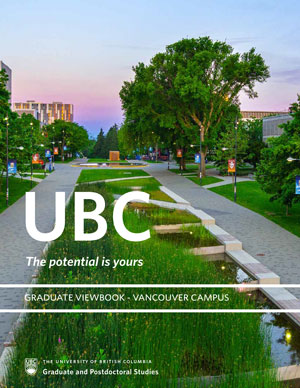Judith Paltin
Research Classification
Research Interests
Relevant Thesis-Based Degree Programs
Research Options
Recruitment
I welcome graduate projects in modernism, understood broadly, twentieth-century Anglophone literatures, postcolonial, cultural, and materialist studies, intersectional work in feminism, gender, race, and sexuality, and media and technology studies.
Complete these steps before you reach out to a faculty member!
- Familiarize yourself with program requirements. You want to learn as much as possible from the information available to you before you reach out to a faculty member. Be sure to visit the graduate degree program listing and program-specific websites.
- Check whether the program requires you to seek commitment from a supervisor prior to submitting an application. For some programs this is an essential step while others match successful applicants with faculty members within the first year of study. This is either indicated in the program profile under "Admission Information & Requirements" - "Prepare Application" - "Supervision" or on the program website.
- Identify specific faculty members who are conducting research in your specific area of interest.
- Establish that your research interests align with the faculty member’s research interests.
- Read up on the faculty members in the program and the research being conducted in the department.
- Familiarize yourself with their work, read their recent publications and past theses/dissertations that they supervised. Be certain that their research is indeed what you are hoping to study.
- Compose an error-free and grammatically correct email addressed to your specifically targeted faculty member, and remember to use their correct titles.
- Do not send non-specific, mass emails to everyone in the department hoping for a match.
- Address the faculty members by name. Your contact should be genuine rather than generic.
- Include a brief outline of your academic background, why you are interested in working with the faculty member, and what experience you could bring to the department. The supervision enquiry form guides you with targeted questions. Ensure to craft compelling answers to these questions.
- Highlight your achievements and why you are a top student. Faculty members receive dozens of requests from prospective students and you may have less than 30 seconds to pique someone’s interest.
- Demonstrate that you are familiar with their research:
- Convey the specific ways you are a good fit for the program.
- Convey the specific ways the program/lab/faculty member is a good fit for the research you are interested in/already conducting.
- Be enthusiastic, but don’t overdo it.
G+PS regularly provides virtual sessions that focus on admission requirements and procedures and tips how to improve your application.
ADVICE AND INSIGHTS FROM UBC FACULTY ON REACHING OUT TO SUPERVISORS
These videos contain some general advice from faculty across UBC on finding and reaching out to a potential thesis supervisor.
Supervision Enquiry
Graduate Student Supervision
Master's Student Supervision
Theses completed in 2010 or later are listed below. Please note that there is a 6-12 month delay to add the latest theses.
A recurring theme in literary modernism is a feeling of alienation in the modern individual. Most critical readings of the modernist city have focused on urbanity as the main site of alienation thus far. However, this approach overlooks the great presence of nature in modernist descriptions of city landscapes. Due to the common impression that nature and city are binary opposites, urban nature is either perceived within cultural conventions of nature or within the context of the natural world. Both of these interpretations lead the reader away from a true understanding of nature as polluted and altered by the city space. Using selected short fiction by James Joyce and Katherine Mansfield, this thesis investigates the ecocritical value of illusory symbolism and characters’ misperceptions of nature in cities of the Western World. During a moment of internal crisis or epiphany, characters often notice the nature in their surroundings, like the snow in “The Dead” or the pear tree in “Bliss”. Other times, the narrator notes the character’s distance from nature in relation to their immorality, like the obscured moonlight in “Two Gallants”. However, the language of covering and blurring used to describe nature reveals its integration with the city. This thesis then proposes a third landscape of ‘urban nature’ in modernist short fiction with its own unique structure of meaning. I argue that the character is aware of this landscape, but applies false symbolism to nature in order to disguise their imperfect lives from modern society. In this way, emotional alienation exposes the city’s alienation of nature in the early twentieth century. This study explores various features of society – namely social normalcy, marriage, and fame – that distances the modern subject from feeling connected to their sense of self, and by extension, to the natural world.
View record
In the past forty years, many critics have increasingly read James Joyce’s Ulysses through attention to the author’s subtle political attachments, focusing particularly on his parodies of Irish nationalism and his anti-colonial commitments. I continue this discussion by examining the novel in conversation with Edward Said’s writings on “exilic consciousness” and “secular critical consciousness,” arguing Leopold Bloom exhibits both through his ability to criticize the Dublin environment he finds himself enmeshed within. He separates himself from his surrounding cultures while still integrating his external environment into his understanding of reality. Conversely, Stephen Dedalus, ostensibly an exilic figure due to his departure from and return to Ireland, fails in establishing an exilic consciousness, as he does not liberate his mind from a subservient, colonized positionality, rather seeking escape in aestheticism, isolation, and material concerns. I particularly examine these two characters in the “Telemachus,” “Nestor,” and “Calypso” chapters in relation to the nationalist forces (Irish, British, and Zionist) prevalent at the time. Then, through application of Frantz Fanon’s post-colonial writings and discussions of national consciousness, in contrast to nationalism, I demonstrate how the novel mocks Irish Nationalist rhetoric without denying its anti-colonial basis. Through a stylistic examination of the “Cyclops” chapter inspired by Roland Barthes Mythologies, I argue that the nameless first-person narrator, antisemitic Citizen, and omnific arranger exhibit similar cyclopean drives for hostile mockery, in contrast to Bloom’s parallactic vision of empathetic love and compassion. Through this vision, Bloom finds a means of resistance even within the hostile Dublin environment that ostracizes him based on essentialized notions of Irish purity, establishing the basis for a national consciousness that can lead into an international consciousness of solidarity among marginalized peoples and groups.
View record
No abstract available.
Many Joyce scholars agree that the first chapter of the Wake's third book is narrated by a donkey (Atherton 2009: 115; Attridge 188; Cheng 36-38; Gordon 45-47; Leland 66; Mierlo 77-79; Norris 17) yet none has explained why Joyce would choose a donkey to both narrate and play the foil to Shaun in a chapter centered around a pointed dialogue between a populist political leader and his audience. This thesis explores the role of the donkey as both character and narrator in the first chapter of the Wake's book of the Democratic Age in order to discover its political aims. In the first part of this thesis, I apply Barbara Dancygier's Narrative Viewpoint theory to trace out a map of the chapter's narrative spaces, triangulating through verb tense and pronoun usage to identify where, when, and how the viewpoints shift. Once this map is created, I then use its topography to analyse the chapter's ecology in the second part of the thesis. Re-reading the map through the magnification lens of Judith Paltin's Modernist Crowd theory, I juxtapose what the donkey says, and where, with what Shaun says, and where, according to the standards set out by Paltin for identifying modernist fascist and democratic crowds. By examining the choreography of their politically charged conversation and analysing their speech patterns and viewpoint shifts according to Paltin's criteria, I discover that the donkey and Shaun are engaged in a verbal political tussle between modernism's democracy and fascism. This thesis concludes that, in the Wake's III.1, the donkey is an avatar of the modernist agile crowd. As such, it presents an early twentieth-century strategy for confronting authoritarian populism head-on in order to create space for democracy.
View record
This thesis examines the ways in which queer/female authors engaged with, altered and represented interwar Paris in two prominent novels: Djuna Barnes’ Nightwood (1936) and Mina Loy’s Insel (1991). Both of these texts are concerned with repressed queer/female subjects who engage with the city in a way that deconstructs bourgeois social mores. I argue that these novels, though often read as “placeless” or “ephemeral,” are, in fact, intimately aware of spatiality, and its potential to serve or repress dissident subjectivities. I employ a theoretical approach that is indebted to “geocritical” scholarship, both recent and ancient, at the core of which are works of: Robert Tally, Michel Foucault and Zeno of Elea. I begin, in my first chapter, by reading the represented spaces of Djuna Barnes’ opus, Nightwood. I examine how Barnes demonstrates disdain for dyadic partitioning of space, and how she instead sees generative potential in a radically osmotic relationship between places. I thereafter turn to Michel Foucault’s theory of “heterotopia” in order to delineate a reading that suggests Barnes sees in her form a potential to figuratively rebuild a world lost to her. In my second chapter I move on to a discussion of Barnes’ friend, Mina Loy, focusing mostly on her novel, Insel, but also attending to her poetry and political writings. Reading Loy’s writings in consideration of her relationship with two radical artistic movements – futurism and surrealism – I parse how Loy crafts spaces indebted to each group’s expressed scientific interest. I focus in on Insel and how its spaces are conceived of as analogous to non-Euclidean geometry, specifically as it was delineated in Zeno of Elea’s “paradoxes,” which were of interest to the surrealist movement. The culmination of this reading ends with my suggesting that Loy’s retention of Insel from the exchange economy was a gesture equivalent to a non-Euclidean conception of infinite space. I argue that these authors’ attention to alternative spaces, when considered together with their writing’s own formal qualities, as well as that of the art depicted within their texts, evidences a vital elucidation of space that thwarts the hegemonic, entirely logical, construction thereof.
View record
In the past ten years we have experienced a mainstreaming of trans politics through the rapid circulation of images of trans people and especially trans children on the Internet in digital communities on social media circling out into traditional media, and in political discourse. This saturation of trans* has led to a regulation of political discourse, new laws (putting “X” in passports as a third gender marker), changing spaces (bathrooms, changing rooms) etc. In this thesis I discuss the figure of the trans* child and what its emergence in the mainstream in the West means socio-culturally and politically in our current moment in the light of the historicity of “the child” as metaphor within medical discourse and its ties to the invention of the sex/gender binary, and sex as a racial phenotype (Gill-Peterson 2018). I further look at the speech activity of trans* children online on the social media platform YouTube and consider what makes the trans* child audible in the mainstream in our current moment? I consider this by thinking with and applying Michel Foucault’s thought on the relationship between truth, power, and the subject in the Western critical tradition in his engagement with parrhesia (truth-telling). Foucault argued in his last lecture series in Berkeley in 1983 that parrhesia did no longer function within the western critical tradition. What I posit in this thesis is that the Internet enables parrhesia to function again through digital communities and social media as a platform to speak truth to power. I argue that the trans* child functions as parrhesiastes in our current moment both enabled by the Internet and by the specificity of the history of “the child” as metaphor within western medical discourse. The trans* child resides between metaphor and materiality in our current moment and it is this ambiguity that allow them to speak truth to power as a parrhesiastes.
View record
In My Ántonia’s final sentence, narrator Jim Burden describes the past as “precious” and “incommunicable,” suggesting that the novel confronts the problem of communicating memory and its subjective value (MÀ 196). One critical paradigm simply asks, “How does one share what cannot be communicated?” (Tellefsen 232). This thesis refocuses My Àntonia’s paradox of “communicating the incommunicable” to the limitations of what literature can communicate as a medium. It considers music as an alternative mode of communication in Jim’s memoir. The permanence of literature, combined with the temporality of music, enables him to capture his memories while conveying their transience. Therefore, analyzing My Àntonia’s intermedial form offers insight into how Jim addresses paradoxes of time, memory, and communication. I reconsider My Àntonia as a work of art or affect, giving special attention to Jim’s artistic process. Building upon Jeffrey Swenson’s assertion that Jim takes “memories of his immigrant friends and set[s] them into […] classical modes,” I demonstrate how Jim uses intertextuality and intermediality as artistic tools to aggrandize his memories (25). He maps Ántonia onto Vergil’s Muse: a method to instill symbolic value. Through intertextuality, she becomes a timeless inspirational figure. Additionally, many of Jim’s memories are described through musical metaphors or occur alongside dances, shows, or plays. Intermediality in the form of musicalized prose is a hyperbolic strategy to communicate incommunicable emotion. Levinasian and Deleuzoguattarian aesthetic theory provide the conceptual framework to explain how Jim makes his art objectively moving. His memoir, an image, is more impactful than reality because it is crafted with what I argue is “rhythm,” an aesthetic force that occurs “in the in-between,” permeates the reader’s senses, and affects their emotions (Levinas 4, ATP 313). By combining multisensory imagery and intermediality, his memoir forces interaction between the five senses and two media, thereby generating rhythm. Through a critical lens combining intermedial studies and aesthetic theory, I argue that My Ántonia is a musical-literary memoir that communicates Jim’s axiological beliefs regarding ephemeral beauty and value. Ultimately, this thesis claims that Jim uses technical intermediality to convert subjective emotional significance into an objectively moving piece of art.
View record
Publications
- Frustrated Energies in Modernism’s Female Arrangements (2019)
- Adaptive Anxieties: Strategic Confrontations in Eco-Joyce: The Environmental Imagination of James Joyce. Eds. Robert Brazeau and Derek Gladwin. Cork: Cork University Press, 2014 (2018)
Journal of Ecocriticism: A New Journal of Nature, Society and Literature, 8.1, 10-12., - Clever, very: Judith Paltin (2018)
James Joyce Quarterly, https://jjq.utulsa.edu/interesting-judith-paltin/, - Music, intermediality, and shock in Ulysses (2018)
James Joyce Quarterly, 53 (3-4), 251-268 - Patternmind' and 'paradigmatic ear': Review of Joyce a long the Krommerun, XXIV International James Joyce Symposium, Utrecht University, 15-20 June, 2014 (2015)
James Joyce Literary Supplement, 28.2., - Temporizing Modernities: Review of Nicholas, Jane, The Modern Girl: Feminism Modernities, the Body, and Commodities in the 1920s and Gifford, James, Personal Modernisms: Anarchist Networks and the Later Avant-Gardes (2015)
Canadian Literature 225 (Summer 2015), 141-2., - Conrad’s Secrets by Robert Hampson (2014)
Conradiana, 46 (3), 218--221 - Problems with theory of mind in Victory (2014)
Conradiana, 46 (1-2), 95-107 - "an infected carrier of the past": Modernist nature as the ground of anti-realism (2013)
ISLE Interdisciplinary Studies in Literature and Environment, 20 (4), 778-794 - Conrad's Agile Crowds (2013)
- A beautiful pure sweet mellow English tenor: Joyce and England at the 18th Irregular Miami J'yce Birthday conference, 31 January-2 February 2013 (2011)
James Joyce Quarterly, 49 (1), 18-21 - Trifling Farce or Lyric Drama? (2011)
The Wildean 39 (July 2011), 116-20., - Grammar by Ear: Teaching Grammar Skills by Immersion and Imitation (2005)
Louisiana English Journal 9 (2005), 35-48.,
If this is your researcher profile you can log in to the Faculty & Staff portal to update your details and provide recruitment preferences.



